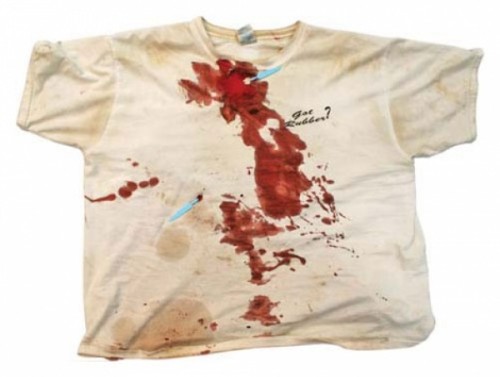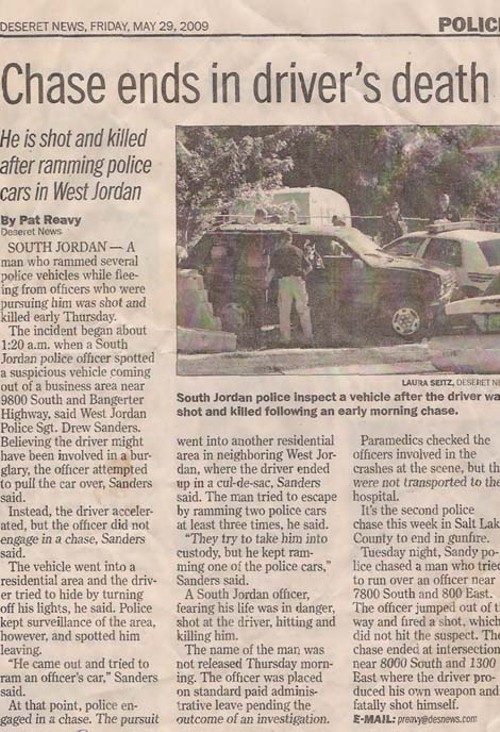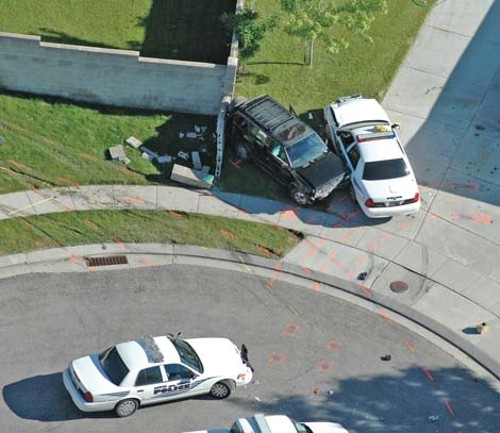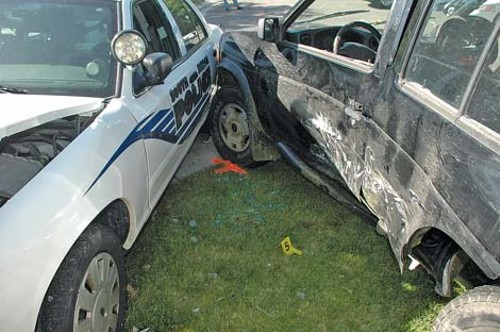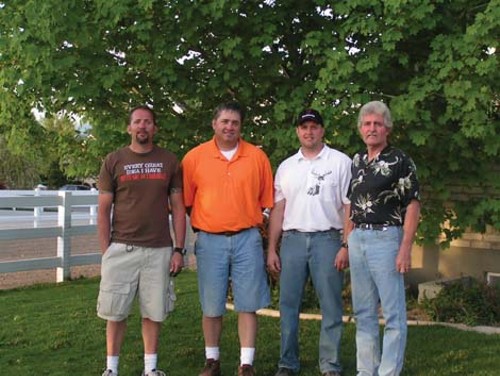Shoot First
South Jordan officers get a pass after killing an unarmed man.
By Stephen Dark @stephenpdark“Oh my God, don’t tell me Wade’s dead,” Judy cried out. Pennington’s father, Garry, collapsed on the lawn of their Kamas home, repeatedly throwing up, until one of his two remaining sons took him to hospital.
An employee of the funeral home, where hundreds of mourners gathered to say farewell five days after Pennington’s death, consoled friends and family, saying he died instantly. Months later, in February 2010, that consolation was taken from them when family members, including Pennington’s 19-year-old son Tyler, reviewed the video and audio recording they obtained through open-records requests from West and South Jordan police departments.
While the dashcam video taken from the patrol cars of the two officers involved—South Jordan Police Department’s officers Jared Nichols and Brett Perez—did not show Pennington’s actual shooting, the audio portion recorded the shouts of the officers and the two gunshots, fired by Nichols, which killed Pennington. According to an interview with investigators three days after the shooting, Nichols claimed he berated Pennington for provoking Nichols’ use of deadly force. “You fucker, why did you do that?” is what he claimed he said to the supposedly dead Pennington.
But, members of the Pennington family burst into tears when they heard the words Nichols had claimed were his. In truth, it was Pennington’s voice on the audio, they realized, not Nichols’. Pennington, they now understood, was still alive moments after being shot. He was hanging upside-down from the window of his black SUV, where Nichols had left him after attempting unsuccessfully to drag him out of the vehicle. And what a weeping Pennington said in his dying moments, as caught on Nichols’ body mic: “I’m fucking shot. Why did you shoot me? You bunch of assholes.”
That question has torn an enormous hole through the lives of Pennington’s family and intimates, in part because Pennington, who fueled a crack-cocaine addiction by breaking into commercial properties at night, seemed finally to be turning his life around. On the day Pennington was buried, he was scheduled to be in court with West Jordan 3rd District Judge Robert Adkins for a hearing that, family members say, may have ended with him released from the criminal-justice system to continue building a new life with 35-year-old girlfriend Russell, who was also his partner in a successful roofing business based in Duchesne County.
From the first days after the shooting, anguish over Pennington’s death gave way to outrage as more and more questions emerged about the shooting and the subsequent investigation, which resulted in Nichols’ actions being ruled as justified by Salt Lake County District Attorney Lohra Miller. While West Jordan Police Department issued a press release the day after the shooting that claimed Pennington was shot because he repeatedly rammed police cars, his family learned through records requests that it was Perez and Nichols who rammed Pennington before the latter shot him. They also learned from records requests that the two officers involved in his death had troubling pasts. According to South Jordan Police Department records, Perez had previously lost his sergeant’s stripes for violating South Jordan chase policy, while Nichols had been one of two shooters in another death 20 months before Pennington’s. Neither of these facts surfaced in the shooting investigation, despite one of the lead investigators, Sgt. Michael S. Leary of the Salt Lake County District Attorney’s Office, having interviewed Nichols for both shootings.
Out of all the doubts and questions that circle the case, perhaps the most fundamental is that Nichols told investigators, “I have no idea who this guy is.” Yet on his own dashcam video, he can be heard shouting, several seconds after he shot Pennington, “Freeze, Wade, I’m going to shoot you. Get down on the fucking ground.” Jarring discrepancies between the dashcam videos of Perez and Nichols and their statements to investigators, combined with the failure of investigators to ask any questions beyond those that ensured a clearance of the shooting, led the family to think that early in the pursuit, Perez and Nichols decided to exact retribution on a career criminal who, despite a slew of recent burglary charges in South Jordan and Sandy two years before, had perhaps gotten off too easy.
The family’s attorney, St. George-based Aaron Prisbey, concludes, “The question is whether you want law enforcement to be judge, jury and executioner.”
On May 27, 2010, the Pennington family filed a multimillion-dollar wrongful-death lawsuit in the central division of the Utah District Court against the two officers involved in the killing, as well as South and West Jordan police departments and their chiefs, the Salt Lake County District Attorney’s Office and Lohra Miller. Legal representatives of the police departments, the District Attorney’s Office, Miller, Leary, Perez and Nichols did not return calls for comment on this story. Miller’s legal representative, attorney Peter Stirba, has however filed a request for sanctions against Prisbey, claiming the lawsuit is frivolous.
In the wake of Pennington’s death, his brothers, Dennis and Dusty Pennington, have been consumed by their search for the truth, a role forced upon them by post-shooting investigators who they argue failed to do their job. They go frame by frame through the dashcam videos, eerily reciting police dialogue with the exact intonation of those involved. “We’re not investigators,” Dennis says, calmly clicking through autopsy photos of his brother that would make most blanche in horror.
Controversy over the district attorney’s investigations of police shootings is nothing new, especially during the four years of Miller’s tenure. Days after she started in January 2006, she dismissed a charge of aggravated assault against Granite School District Officer Richard Todd Rasmussen. The charge had been filed by Miller’s predecessor, David Yocom, two years before, following Rasmussen’s shooting of unarmed Anthony Chavez after a high-speed pursuit. Miller also declined to prosecute two sheriff’s deputies despite declaring their shooting of a theft suspect unjustified. In that instance, the district attorney’s investigative report noted there was not a “reasonable likelihood” her office could get a guilty verdict from a jury. In total, according to an open records request of the Salt Lake County District Attorney’s Office by City Weekly, law enforcement personnel within the county used deadly force 48 times during Miller’s term, resulting in 24 fatalities. None of the shootings resulted in a prosecution of law enforcement.
The controversy over Pennington’s May 2009 shooting, however, coming in the final weeks of Miller’s administration after she lost her office to Sim Gill in the November 2010 election, offers a disturbing portrait of a system that appears to provide little to no scrutiny of officers’ actions when deadly force is used.
Utah Association of Criminal Defense Lawyers Executive Director Kent Hart, after viewing video from the shooting, calls for the case to be reopened by an independent body. The shooting investigation “was not adequate,” he says. “There are many questions that are unanswered coupled with a lot of red flags.”
Defense attorney Jeff Hall, who represented Nichols in the initial post-shooting interview, cautions that officers caught up in shootings are in “very difficult situations” and should be “afforded a substantial amount of deference. You need to stand in the shoes of an officer in the moment to appreciate the dynamics of the situation.”
But Pennington’s family, still struggling to deal with the horror of that night, cannot countenance anything they see as resembling excuses. Among the final words Pennington heard came from Perez: “You’re dead, motherfucker.” Tears in his eyes, Garry asks, “How does that feel?”
SMASH AND GRAB
Wade Pennington grew up in Murray, the son of a Chicago Bridge & Iron Co. welder and a mother who was a medical clerk. His father recalls Pennington as an avid bowhunter, fisherman and camper, who struggled with addiction most of his adult life. To support that addiction, he burgled commercial properties at night, throwing a large rock through a store or business’ front window and then running through the business with a crowbar to grab cash or items he could pawn for crack money. Prisbey says Pennington’s choice to burglarize stores after they were closed reflected his fear “of hurting people or being hurt himself.”
In 2001, 3rd District Court Judge Leslie Lewis sent Pennington to Utah State Prison in Draper for a probation violation for felonies he’d committed in West Jordan. While in prison, Pennington achieved the dream of many inmates and convinced Utah courts, through his own pro se representation, to send his case back to court for review. That ultimately led to the sentence being “reversed/vacated,” according to prison records and his release just before Christmas 2005.
On Jan. 4, 2007, Sandy City Police detective Chuck Thoman arrested Pennington as he fled a business he had just burglarized. In the Sandy police station, relatives say, he made a deal with Thoman that, in exchange for confessing to more than 22 burglaries in Sandy and in South Jordan, the officer would help him get into drug court. Thoman filed charges for the Sandy-based crimes, while South Jordan Police Department Sgt. Allen Crist filed the South Jordan charges.
In exchange for pleading guilty, 3rd District Court Judge Robert Adkins placed Pennington on probation and put him into drug court in Vernal, which was the only available drug court at the time. He and Kristi Russell built up a burgeoning roofing business in Duchesne County, even purchasing seven acres of land on which they began building a home. But the Pennington family lawsuit alleges that both West and South Jordan police “were upset” at Adkins’ decision and that when Pennington was visiting friends and family in the valley, police routinely pulled Pennington over “without reasonable suspicion or probable cause” in order to get his probation revoked and Pennington back behind bars.
After a fellow drug-court client in Vernal reported Pennington for buying beers, Pennington was jailed and transferred to Salt Lake City to appear before Adkins. Letters to Adkins from Pennington’s family, girlfriend and roofing clients all attested to how much he had turned his life around in the past two years, and after Pennington passed several comprehensive drug tests, the court apparently agreed. Adkins told Pennington, his parents say, that if he paid $2,000 in restitution by June 2, 2009, and continued doing one-on-one counseling for his addiction, he could forgo drug-court supervision. “Wade was so happy,” Russell says.
The court docket, however, shows only that Pennington was to return on June 2 for sentencing on violations of his original agreement to plead guilty in exchange for entering drug court.
DEAD AT THE WHEEL
Three days later, just after 1:24 a.m. on May 28, 2009, Sgt. Crist spotted a black SUV outside the now-closed Family Motor Sports store near Bangerter Highway in South Jordan. When the SUV took off, Crist radioed its description and plate, but rather than follow what he described as a burglary suspect, stayed at the premises and waited for a K9 unit to inspect the building. When Perez radioed he had spotted the car, Crist told him not to pursue but to confirm the plate.
Fourteen minutes later, Pennington was dead.
Piecing together what happened that night is much about what isn’t in the videos, audio recordings and subsequent interviews. Along with missing audio, Nichols’ dashcam video has no time code. In addition, either the camera was pointed to the right side of Nichols’ windshield, or the driver’s side of the image has been removed, the remainder then elongated into a widescreen image. “To me, the video doesn’t tell the tale,” Prisbey says. “It doesn’t tell you it’s not justified.” The truth, he argues, emerged as he contrasted the videos with the transcripts of the investigators’ interviews with Perez and Nichols. “Their story was made out of old cloth.”
After months of reviewing official documents, Prisbey and Pennington’s brothers assembled what they believed were the events of that night after Crist alerted colleagues to the fleeing SUV. Why Crist did nothing as subordinate officers ignored his direct order and went after the SUV isn’t clear. The store that Crist saw Pennington outside of was later found to not have been burglarized.
According to a South Jordan report from that night, the police dispatcher radioed that the car belonged to Kristina Russell, although the lawsuit claims the South Jordan dispatch tape “has been edited,” with several minutes missing, including any reference to Russell. The lawsuit alleges those missing minutes would have shown that South Jordan law enforcement “did in fact know the identity of Pennington before he was shot and killed.” Perez radioed dispatch that Pennington tried to run him over, thus justifying the chase Nichols had already begun. Yet Nichols’ dashcam video, according to the lawsuit, “demonstrates that Perez was never in danger of being hit by Pennington at any point.” Even more disturbing, Perez told investigators he did not believe Pennington was trying to run him over. “I’m not saying that he was—I mean, I think, if he wanted to run me over, he would have hit my car.” Later in the interview, he states, contradictorily, that Pennington “tried to run me over.”
Nichols chased Pennington through West Jordan residential neighborhoods. While Nichols radioed in several times that Pennington had rammed him, his video shows that, on more than one occasion, Nichols was the aggressor. “I’m going to take him out,” Nichols radioed dispatch, and then proceeded, along with Perez, to repeatedly ram the SUV, Pennington’s vehicle finally wedged between a cinder block wall by the side of a house and Nichols’ patrol car.
Perez leaped out of his patrol car, gun drawn, and took aim at Pennington from the passenger side of the SUV. He shouted at Pennington, whom he told investigators he could see with his hands on the steering wheel, “to get out on the ground. Stay where I can see you.” Perez told investigators he did not consider shooting Pennington because he “didn’t perceive a threat,” but rather circled around, intending to tackle him as he got out of the car.
Meanwhile, Nichols’ and Pennington’s cars were facing in opposite directions, the two drivers’ windows directly across from each other, barely three feet apart. While Pennington’s window was rolled down, Nichols’ was rolled up. Whether or not Pennington could hear him, Nichols shouted, according to the lawsuit: “Freeze or I will shoot you. Freeze.” He then shot Pennington through the closed police-car window twice in the chest. Although he later told investigators he did not know the driver, on Nichols’ audio recording, he shouted Pennington’s name while ordering him to the ground.
Nichols got out and then tried to pull the wounded Pennington out of the car, but his foot was stuck behind the steering column. “Fuck,” Nichols said, and left Pennington hanging upside down, the last seconds of his life pulsing away.
As law enforcement officials gathered in the driveway, the Penningtons’ lawsuit claims Nichols said, “There goes my job,” after realizing Perez’s dashboard camera was still on. Perez replied, “Sorry, man.” Documents from South Jordan Police, however, show that officers claimed it was Perez who bemoaned the future loss of employment, in reference to his previous demotion for violating chase policy.
A subsequent South Jordan Police internal review of the pursuit included several officers criticizing Crist for not supervising his subordinates’ chase, one officer even going so far as to say he would not work with either Crist or Perez after their behavior that night. In November 2009, Perez quit the South Jordan Police Department.
Nichols, on the other hand, despite violating policy by driving at high speed through two red lights in West Jordan without slowing before each intersection, was nevertheless deemed by one sergeant to have done “a great job.”
“WERE YOU SCARED?”
Jared Nichols’ South Jordan personnel file boasts commendations and letters of recommendation for his dedication to his work. He emerges as an assertive, tenacious officer, valued by South Jordan, according to one commendation, for his experience and knowledge dealing with gangs gleaned from an assignment to the Metro Gang Task Force. Nichols’ “proactive patrolling,” as a superior describes his approach to policing, extends to chasing down an unarmed juvenile Nichols later wrote had been involved “in causing mischief,” with his “duty weapon draw[n] and at low ready.” He also can display a temper. In November 2009, Nichols received a written warning for insubordination after he yelled at Crist following a training session. The warning noted “the current climate” between the sergeant and the officer, although whether that referred to Crist not backing him up while pursuing Pennington is unclear.
One past event not included in the personnel file Pennington’s family received through a records request was Nichols’ involvement in a prior shooting. Prisbey only knew Nichols had shot someone else while on duty because Perez mentioned in his interview with investigators that Nichols had just finished “initiating,” which Prisbey correctly surmised referred to a prior shooting Nichols had been involved in.
Twenty months before Pennington’s death, on July 14, 2007, Nichols and a second officer fatally shot white supremacist Darren Neil Greuber at an apartment complex on 5601 S. Redwood Road. At that time, Nichols was on assignment with the Metro Gang Unit. He had gone with a team of 11 officers, some members of Taylorsville’s SWAT team, to arrest Greuber as “a favor,” to a Taylorsville officer also assigned to the gang unit, according to Taylorsville Police Department documents. When the unarmed Greuber tried to escape by ramming his car against numerous parked cars, two officers, one of them Nichols, shot him.
Prisbey alleges the shooting-investigation team, which included Sgt. Leary of the District Attorney’s Office, failed to address key questions, the most important being a witness who claimed that someone shouted, “He’s got a gun, he’s got a gun.” In a situation such as the arrest of a man records show officers suspected was armed, those words would surely have been Greuber’s death warrant. Nowhere in the reports of interviews with the two officers, however, was that witness’ statement addressed.
A few hours after Pennington’s shooting, Leary and West Jordan Sgt. Travis Rees interviewed Perez. Two days later, they talked to Nichols. Nichols told the investigators that prior to the interview, he and his wife had been taken to dinner by his lieutenant, and Nichols had requested and been given a copy of his dashcam video to study.
Prisbey believes such stark collaboration with someone who is essentially a criminal suspect still pales, however, beside the lack of questions posed by investigators. Family members claim investigators did not ask Nichols why parts of his dashcam video had no audio; why, if he claimed he did not know the man he killed, he nevertheless called out his name; and why he tried to pull the body out of the car. That Leary saw fit not to mention Nichols’ prior shooting, especially since he himself investigated it, is equally difficult for the family to understand.
But the biggest question for Pennington’s family is why Nichols shot him. According to the transcript of Leary and Rees’ post-shooting interview with Nichols, he told Rees he shot Pennington because he “made a lunge towards me,” a move that made him feel “really uncomfortable.” Rees subsequently claimed in a report that Pennington “ignored all of the commands given by the officers and jumped out his window at Officer Nichols.” That Pennington could have managed to, in the last few seconds of his life, maneuver into position to jump out of his car doesn’t ring true for his family, particularly given that he died with one of his legs hooked under the SUV’s steering column.
Nichols went on to tell Rees he did as he was trained, saying, “Freeze or I’ll shoot. Freeze or I’ll shoot,” but Pennington “just kept coming.” Nichols had no time other than to perceive “he’s not complying to what I’m saying,” so he shot him.
Since the 1985 U.S. Supreme Court case of Tennessee v. Garner, officers who use deadly force against a fleeing suspect have to show he or she poses a significant threat of death or physical injury to the officer or others. After Leary and Rees took a break, they came back into the West Jordan interview room and pressured Nichols on one point: As Pennington “lunged” toward Nichols, “Were you scared?” Rees asked.
“I’m cornered,” Nichols said. “I don’t have anywhere to go. I’m—I don’t know what he’s going to do. I’m stuck in a car.”
“Were you scared?” Rees repeated.
“Yes, I was scared, I guess. I—I don’t know.”
No trajectory evidence, according to the reports provided to the Penningtons, was gathered to determine where Pennington was shot. If Pennington’s location when shot was shot isn’t clear, neither is when he died. Nichols requested medical care for Pennington but did not check Pennington’s vitals, he told the investigators, as he appeared dead. “I just walked away from the scene,” He was pissed, he said, that Pennington “made me do what I had to do.” The lawsuit claims “neither Nichols nor Perez did anything to assist Pennington, even though Nichols knew Pennington was still alive.”
FLEEING FOR HIS LIFE
Of all the lingering questions surrounding the death of Wade Pennington, one of the most painful for his family is why he ran in the first place.
Dawn Boggs, the mother of Pennington’s son Tyler, says Pennington was afraid of very little. One day, while out fishing, she joked, “Wade, the cops are gonna get ya.” He replied, “They won’t shoot a guy like me.”
But when she saw him on the dashcam video, “I knew by the look on his face, he was scared to death. He knew they were out to get him.” Normally, she says, after a few minutes, Pennington, who had successfully evaded capture by the police in the past, would have given himself up. But that night “he knew something was wrong,” she says. “At some point in those [final] minutes, he knew if he didn’t get away from [Nichols] he was going to die.”
A year and half after Pennington’s death, the wound it opened in the lives of those who loved him refuses to heal. “None of us can get past it,” Boggs says. “We meet up at La Frontera” where he used to gather the family, “but it’s not the same.” His son, Boggs says, has been plagued by depression since his father’s death, and will “literally not come out of his room.”
Girlfriend Russell says, her voice breaking, that law enforcement “has no idea what they took away.” His mother says she can never “be fully happy again,” can never forgive Nichols nor the police departments that lied to her family, painting Pennington as a dangerous, violent man that he never was.
“No dollar amount can bring him back,” Judy Pennington says about the family’s lawsuit. “They took something very precious to me. They took my son.”
More by Stephen Dark
-
Call it a Comeback
Long mired in economic depression, Midvale’s Main Street dusts off its small-town charm.
- Sep 20, 2017
-
Love Letters
Correspondence between a young woman at the Topaz internment camp and her beloved sheds light on Trump's America.
- Sep 6, 2017
-
Triggered
Veterans Affairs exists to help vets. So why did the Salt Lake VA appoint an anti-veteran chief?
- Aug 30, 2017
- More »
Latest in Cover Story
Readers also liked…
-
Forget the family pedigree—Robert F. Kennedy Jr should not be the next president of the United States
Trojan Horse
- Jun 21, 2023
-
Women decry harassment and toxic culture at St. George auto dealership
Men at Work
- Oct 11, 2023


